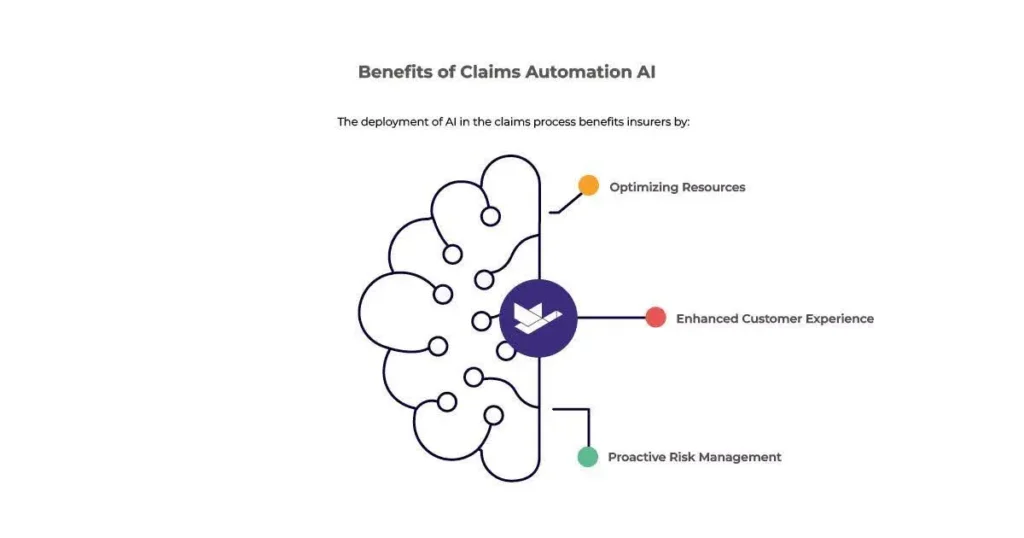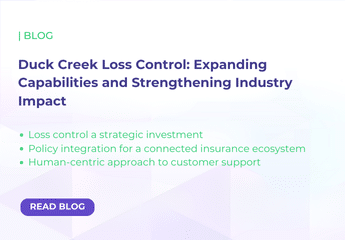The rapid ascent of Artificial Intelligence (AI) is redefining the insurance landscape, making the notion of artificial intelligence in insurance claims a focal point for industry leaders, and transforming the way insurance companies operate. With AI claims, companies are witnessing a shift towards smarter automation and processes in claims that not only enhance operational efficiency but also drastically improve client satisfaction.
In claims processing, AI-driven technology streamlines the claims workflow, from initial report to final settlement, ensuring swift resolution. For insurers, this translates to improved accuracy in claims handling and a more robust defense against fraudulent activities.
What Does AI do for the Claims Process?
Claims, wielding the power of AI, performs a critical analysis of claims data, harnessing both structured and unstructured forms. Utilizing algorithms for pattern recognition and predictive analytics, this technology mines data in real-time, flagging discrepancies and accelerating the claims lifecycle.
-
Promote Efficiency
AI revolutionizes the claims process by automating repetitive tasks such as data entry and document classification based on content. It enables the straight-through processing of claims that meet predetermined criteria, which significantly speeds up resolution times and meets the increasing expectations of policyholders.
The value of Generative AI becomes apparent in summarizing extensive documents like medical reports and legal briefs. It utilizes predictive models to highlight high-risk factors to the adjuster, recommending immediate next steps to prevent claim escalation.
The efficiency improvements not only support claims handlers by allowing them to engage more meaningfully with customers but also play a crucial role in enhancing customer retention.
-
Manage Increasing Costs
The surge in efficiency inevitably leads to cost reductions for insurers. By capturing key performance indicators (KPIs) of claims staff, insurers can make informed, transformative business decisions with curated, near-real-time data.
This efficiency reduces the reliance on manual processes, which further drives down operational costs. Such financial savings are instrumental in managing the increasing costs associated with claims processing, providing a financial cushion that allows for more strategic investments and innovations within the insurance sector.
-
Enable Intelligent Decisions with Predictive Analytics
Utilizing predictive analytics, insurers are empowered to make more data-backed and confident business decisions. This technology facilitates a deeper understanding of the complexities involved in each claim, allowing claims handlers to streamline their next steps effectively.
Predictive analytics leverages historical data and AI-driven insights to forecast future trends and identify potential risks, enabling the claims team to proactively address issues before they escalate. This not only enhances the accuracy of claim resolutions but also optimizes the overall claims management solution which ultimately improves policyholder satisfaction. The impact of AI technologies in this transformation cannot be overstated.
AI Usage Trends Shaping the Future of Insurance Claims
With the rise of AI usage in the insurance industry, the way AI is leveraged in insurance claims is also witnessing several changes that are setting the stage for the future. Insurers may expect to see more AI usage in insurance claims in these three areas below:
-
Increased Telematics Usage
As the usage of telematics increases, so does the importance of AI in enabling real-time claims submission. Telematics will deliver real-time data, enabling faster accident reconstruction, fraud detection, and personalized services for faster claims processing.
-
Higher Computer Vision Usage for Damage Assessment
Similar to how telematics uses sensors to gather driving data, AI with computer vision capabilities can analyze photos and videos submitted with claims. This allows for faster and more accurate damage assessments, especially for property claims like car accidents or home repairs. Insurers can then provide repair approvals or quotes.
-
Conversational AI for Personalized Claim Interactions
Data collection and analysis is part and parcel of most AI-enabled software. In claims, AI enables hyper-personalized policyholder experiences. By understanding customer preference and drawing on information available in their database right from the start of an AI-powered claims process, potentially enhancing customer engagement and loyalty.
With these up and coming trends, the rise of AI application in the insurance sector not only streamlines the claims process but also promises a significant overhaul in how claims are managed and processed.
As we segue into the nuances of AI in claims automation, it is pivotal to recognize that these advancements are not just technological upgrades but are reshaping the foundational elements of customer service and operational efficiency in the insurance industry. But how exactly does AI integrate into claims automation, and what does this mean for insurers?
Artificial Intelligence in Claims Automation
The crux of artificial intelligence in insurance claims lies in its ability to process vast amounts of data, including those gleaned from satellite images, social media, and IoT devices.
This integration allows for a thorough assessment of claims, ensuring that legitimate claims are paid promptly, and dubious ones are duly investigated. At the same time, data quality and AI expertise are pivotal in harnessing the full potential of AI in claims automation.
However, insurers still need to understand the core operational mechanisms of AI claims processing to harness its potentials to the fullest. To start, AI applications in claims handling work through the integration of machine learning algorithms and natural language processing (NLP) to dissect and interpret claims documentation and related communications.
-
Automated Data Extraction
Crucial information is extracted from submitted claims forms and supporting documents, enhancing data entry accuracy and reducing errors. In an ideal AI-powered insurance claims solution, the exact documents the data was extracted from would be cited. AI can also capture data points from unstructured data to help claims experts find similar claims in their database. Throughout the claims submission process, AI-powered channels such as chatbots use advanced technologies such as natural language processing (NLP) to better understand and quickly resolve policyholder requests.
-
Predictive Claims Routing
Claims are promptly categorized and routed to the appropriate claims handler or automated system, improving response times and customer experience. As new information becomes available, the claims can be recategorized. Depending on the information available, a claim could be directly processed or rerouted to the right person for handling as well.
Considering the extensive capabilities of AI, it is imperative for insurers to calibrate their processes to include automation and analytics that align with their operational ethos and customer commitment.
Benefits of Claims Automation AI
The deployment of AI in the claims process benefits insurers by:

1. Optimizing Resources
Brings about a strategic redistribution of human capital, focusing on high-impact areas where expertise is crucial. With AI as an assistive tool, the amount of manual processes are also reduced, allowing the claims team to redirect their resources elsewhere, such as on training new claims employees, tackling escalated claims tickets, and so on.
2. Enhanced Customer Experience
Automation enables faster response times and smoother interactions during the claims process. Policyholders benefit from quicker resolutions and improved communication, leading to higher satisfaction levels.
3. Proactive Risk Management
AI anticipates potential risks and suggests preventive measures, contributing to a more resilient and forward-thinking claims strategy.
Implementing AI Claims Automation in Your Business
Implementation is a meticulous journey that involves strategic planning and investment. To deliver efficient implementation a procedural roadmap to assist in streamlining the process is needed:
-
Capacity Analysis
Scrutinize your current process to identify potential bottlenecks that AI can resolve.
-
Vendor Selection
Choose a tech partner, with proven AI expertise and a strong support infrastructure.
-
Pilot Programs
Start with a small-scale pilot to quantify the benefits and refine the system before wide-scale deployment.
Considerations when Implementing AI in Claim
Data Integrity & Data Governance
Acknowledging the various enhancements AI introduces to claims processing, insurers must also grapple with formidable challenges to its implementation. The top challenge faced is ensuring data integrity — the foundation upon which AI models are built.
Without high-caliber data, the outputs of even the most sophisticated AI systems are compromised, magnifying the risk of inaccurate claim resolutions and obstructed customer satisfaction. Learn more about how Duck Creek Clarity provides insurers with curated data and insights to better grow their business here.
And herein lies the crux: adoption of AI is not just about integrating cutting-edge technology—it’s a comprehensive paradigm shift demanding meticulous data governance and a commitment to transparency in algorithmic decision-making.
Awareness of the Regulatory Landscape
Insurers must also remain vigilant of regulatory landscapes that are continuously evolving in response to these technological advancements, even while adopting AI into their daily workflows.
For instance, as the usage of AI rise, so are the concerns surrounding its usage, especially in the insurance industry. Insurers can expect to see more AI usage regulations aimed at protecting customer data privacy and usage transparency in the near future.
Concurrently, insurers will have to apply other new regulations for the insurance industry as they arise, and ensure that they stay compliant with or without AI.
Company Culture & Hiring the Right People
For genuine transformation, insurers will be required to foster a company culture that fully comprehends and embraces the intricacies of AI. A strategic roadmap including workforce training and stakeholder alignment is pivotal for a seamless transition into an AI-enabled future.
Present: At its present stage of maturity, many claims handlers and even claims executives are still skeptical of machine learning, automated processes, and their accuracies. Keeping a human in the loop is imperative at this stage to mitigate risk for AI hallucinations and to ensure output accuracy. During this early adoption phase, insurers should make sure people are being utilized where they matter most, such as in customer servicing.
Despite the caution towards AI in claims, the fact still stands that claims teams want to automate some of these manual tasks for higher efficiency, highlighting the need for insurers to transition to an AI-enabled future.
Transition: In discerning the suitability of AI for claims automation, it’s crucial to understand your organization’s readiness to embrace digital change. To support this transition, carriers should first build trust for AI/ML models by ensuring that a claims handler is reviewing the model’s suggestions in the first few iterations of its usage.
This can also be configured to surface the results of an AI/ML model and recommend the next best action. The user can then reject or accept the recommended action, offering a streamlined process for the user to engage, thus offering a faster response and improved customer service.
Workflows can be fully automated after a claims handler has a high agreement rate with the AI/ML model, e.g. at 90%. Automations like this are best applied for processes requiring high claims volumes, as it maximizes the potential savings and efficiencies. As more insurers go through this transition, so will the number of insurers using this process as their ‘default state’.
Future: Having built the trust and workflows for automated processes, especially for high claims volumes, AI can effectively alleviate the administrative burden on your workforce. To maximize the benefits of AI in insurance, insurers can pair its usage with a robust data ecosystem — complete with high-quality data and advanced analytics capabilities.
Use Cases and Real-world Examples
Practical applications of AI claims processing are already yielding substantial results:
-
Predictive Risk Modeling
By analyzing historical data and emerging trends, AI systems enable insurers to predict future risks with increased precision, leading to more accurate premium setting and reserve allocation. This foresight goes a long way in optimizing financial planning and enhancing competitiveness in the insurance market.
Carriers are also able to evaluate new data as it comes in, accurately tracking the risk of the claim as it goes through the claims handling process. Insurers can utilize AI to evaluate which claims are consistently handled in the same manner, making them candidates for automation. This feature allows insurers to find other claims that are similar, such as cases related to a fraudulent claim, by identifying data patterns.
As a result, AI being used for predictive risk modelling in a claims process would allow claims handlers to be more efficient and spend less time on routine tasks.
-
Claim Handler Assistance and Support
AI supports efficient triaging of claims, ensuring that they are straight through processed or evaluated and routed to the correct handler based on complexity and priority. This helps insurers reduce cycle times for claims resolution, carry out the next best actions, and deliver higher-quality service, solidifying their reputation as customer-centric market leaders.
In this process, AI empowers your claim handlers to make smarter decisions, which in turn, create better outcomes. Claims handlers are then able to focus on a policyholders-centric experience, giving their requests faster turnaround time, creating a happier customer base.
-
Training New Claims Handlers
With AI-enabled chatbots or virtual assistants, new claims handlers can access on-demand support during their onboarding or trainings, such as answering questions or clarifications on specific policies, accelerating the learning process.
-
Automated Damage Assessment
AI facilitates a seamless damage evaluation by processing and interpreting sensor data and satellite imagery, significantly reducing the timespan between claim filing and settlement, ensuring policyholders can commence rebuilding post-disruption without undue delays.
Step Confidently into the Future of Claims Automation with Duck Creek
Embrace the power of AI and step into a future where tailored claims management sets the benchmark. With Duck Creek’s pioneering AI-enabled claims solutions, insurers can ensure resilience, agility, and an emphatic customer-first approach.




